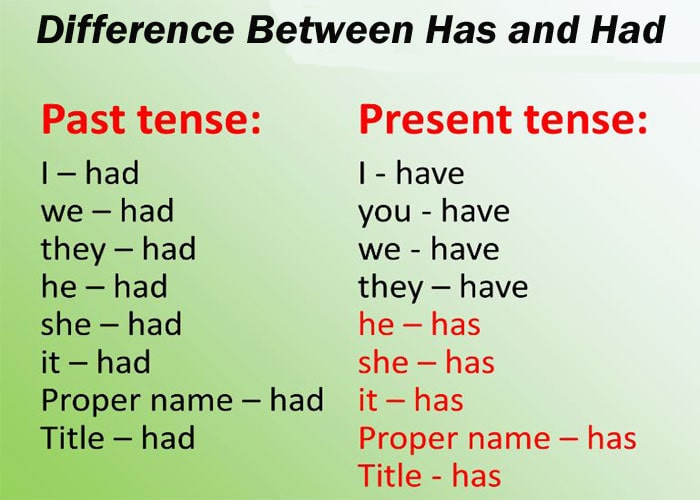English is an international language that we know. Has and had is the part of Tense. It’s called a verb. These express a question, statement, request, suggestion, command, and exclamation. You’ll get here the Difference between has and had with examples.
In Tense, the verb has that used to proclaim the present perfect Tense; otherwise, the verb “Had” is used to reveal the past perfect Tense. One of the most common grammar mistakes students make is using the past tense when it doesn’t need to be. For example, in the sentence “I ate the cake,” the past tense is incorrect because the action of eating has not yet occurred.
The correct verb would be “I ate.” The same goes for other verbs like “stepped,” “saw,” and “spoken.” To avoid common grammar mistakes, become familiar with the correct Tense of each verb and use it correctly whenever necessary.
Definitions and examples of Has and Had
The Verb ‘Has’ is transitive and requires a direct subject. We know that it’s the 3rd person singular number present tense. We can see it as an example ‘Rahim has gone’ here ‘gone’ is the object of the verb ‘has’.
The verb ‘Had’ is a transitive verb, but here is an adequate difference used while mentioning something proclaimed in the past tense. It is also used for announcing to the third person. For example: “He had played” here is the object of the verb had. It contains the past situation.
“Has” and “had” are both forms of the verb “to have,” but they have different timeframes:
Has: Present tense, used for things happening now or habitually.
- Sarah has two cats. (She owns them currently.)
- He has breakfast at 7 am every day. (He does it regularly.)
Had: Past tense, used for things that happened before now.
- She had pizza for dinner last night. (She ate it in the past.)
- They had a great vacation in France. (It was in the past.)
What is the difference between has and had?
The primary difference between “has” and “had” is their tense:
- “Has” is the present tense form of the verb “have.” It is used with singular subjects (he, she, it, a singular noun) to indicate possession or to form the present perfect tense (e.g., “He has a book” or “She has finished her work”).
- “Had” is the past tense form of the verb “have.” It is used to indicate possession or to form the past perfect tense (e.g., “He had a book” or “She had already finished her work”).
Has VS Had examples
Your concept will be clear after seeing their examples with the sentence. For this reason, I’ve tried to give some examples of the verb has so that you can check and gather knowledge about them. Now, let’s see the verb has and had models.
‘Has’ examples
The examples of the verb has’ is given here.
- If one of us has to leave, I’ll go there.
- He has a car
- Rahim says he has a cold.
- Do you know how much it has cost USD
- He has with you, but now he forgets me.
- He has been here about three hours.
- We could say the fruit has excellent taste.
- She has to go to the shop.
- They did another Covid-19 test this morning, and the infection has spread to the other lung.
- Has your mother always taken care of her child?
‘Had ‘examples
The examples of the verb had’ sentence is given here.
- He had a car
- I wish I had never come to the party.
- Certainly, she had been under a lot of problems.
- He had a cat but, it died.
- It is a long time since I have had any sleep, and I’m very tired.
- What had they done the task?
- In fact, he had given her strict orders not to get anything.
- He had the most expressive face he had ever seen.
- I had no idea about that.
- In a few minutes, they had forgotten about the dog.
Difference between has and had with tables
Do you know what the difference is between has and had? Now, let’s see their differences with examples are given here. Below is a user-friendly, unique, and eye-catching comparison table that highlights the differences between “has” and “had.” The table is designed to be visually appealing and easy to understand for students, with added value in the form of examples and usage tips.
Difference Between “Has” and “Had”
| Aspect | Has | Had |
|---|---|---|
| Tense | Present Perfect Tense and Has is the 3rd person singular and present tense of have. | Past Perfect Tense and Had is the 3rd person singular past tense and the past participle form of ‘have’ |
| Usage | Used for actions or events that started in the past and continue to the present or have just been completed. | Used for actions or events that were completed before another action or event in the past. |
| Subject | Used with third-person singular subjects (he, she, it, or singular nouns). | Used with all subjects (I, you, we, they, he, she, it, and plural nouns). |
| Example | – She has finished her homework. – The train has arrived. | – She had finished her homework before the movie started. – The train had arrived by the time we reached the station. |
| Time Reference | Refers to the present or recent past. | Refers to a time before another past event. |
| Auxiliary Verb | Used with “has” + past participle (e.g., has eaten, has gone). | Used with “had” + past participle (e.g., had eaten, had gone). |
| Common Phrases | – Has been – Has done – Has gone | – Had been – Had done – Had gone |
| Key Tip | Think of “has” as connecting the past to the present. | Think of “had” as connecting two past events. |
Read also related topics: Why is English Grammar So Hard?
What is the Difference Between Idiom and Proverb?
What is The Difference Between Shall and Will?
What’s the difference between has and had?
- Has: Present tense of “to have,” used with he, she, it, or singular nouns to indicate possession or a present state.
- Had: Past tense of “to have,” used with all subjects to indicate possession or a state in the past.
Examples
- Has:
- He has a car.
- She has finished her homework.
- Had:
- He had a car last year.
- She had finished her homework before dinner.
Uses
- Has:
- Indicating current possession: “She has a dog.”
- Present perfect tense for actions that occurred at an unspecified time before now: “He has traveled to Japan.”
- Had:
- Indicating past possession: “They had a house in the city.”
- Past perfect tense to describe an action completed before another past action: “She had left before he arrived.”
Study Tips for Students
- Practice with Examples: Write 5 sentences using “has” and 5 sentences using “had” to reinforce your understanding.
- Timeline Visualization: Draw timelines to differentiate between “has” (present perfect) and “had” (past perfect).
- Spot the Difference: Identify “has” and “had” in books or articles to see how they are used in real contexts.
- Quiz Yourself: Create flashcards with sentences and test yourself on whether to use “has” or “had.”
Quick Quiz
- She ___ already eaten breakfast. (has/had)
- They ___ left before the party started. (has/had)
- He ___ never been to Paris. (has/had)
- By the time we arrived, the movie ___ already begun. (has/had)
Answers: 1. has, 2. had, 3. has, 4. had
You may give a full test for improving present perfect tense quiz and rate yourself.
People also ask
Why is “has” used in the past tense and “had” used in the past continuous?
“Had” is the past continuous verb form of “have,” which is the third person singular present tense verb. This verb form is used when something is happening continuously in the past. If we see, the American High School education are teaching their students about it before going to college.
What is the difference between “has” and “had”?
“Has” is used to say that something already exists in the present and “had” is used to say that something has already happened.
How do you use “has” in a sentence?
The subject has a right to do something in the present.
In conclusion
Thank you for reading the content. We hope this blog has provided you with the information you need to understand the past and present tense.
Besides, if you think any data give an error or face any problem understanding, feel free to ask.

